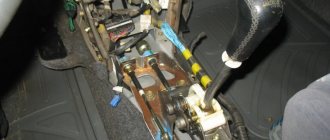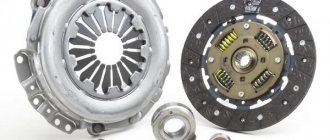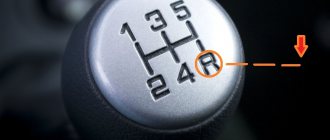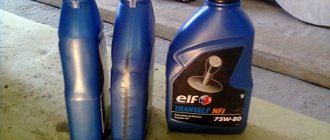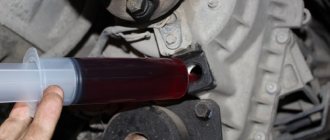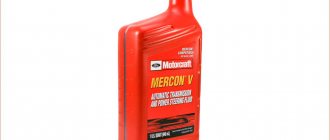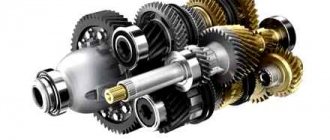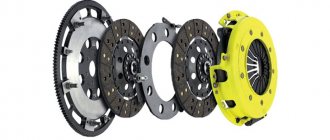The reason for unclear switching and extraneous sounds when changing gear levels does not always lie in the gearbox itself. Much more often, gears shift poorly due to wear/breakage of the clutch or play in the gear selection mechanism. In this article we will look at common faults that cause problems with gear shifting, and methods for diagnosing them.
The box “crunches” when switching
Crunching is the characteristic extraneous sound that occurs when changing gears. Reasons for this phenomenon:
- malfunctions of the clutch and its release drive, due to which, when the pedal is depressed, the driven disk remains in engagement with the flywheel (in such cases it is often said that the clutch “drives”). Sounds when changing gears are often accompanied by a tight movement of the rocker, so to change gears you need to apply quite a lot of force;
- insufficient amount of oil in the gearbox;
- incorrect adjustment of the clutch release cable drive;
- wear of synchronizers in the gearbox.
Theory of gearbox operation
At the moment, all modern gearboxes are equipped with synchronizers, which are important elements of the gearbox. The essence of how synchronizers work is that they equalize the operation of the gearbox shafts.
Every driver, when switching from second to first gear, has encountered a situation where some kind of obstacle was felt. What prevents you from engaging first gear while driving. This is the synchronizer.
If you have a fairly new transmission, then when switching from an upshift to a downshift you will not find yourself in such a situation. Switching will be carried out without problems. This manifests itself as the components of the unit are used and worn out.
Watch a video about the design and operating principle of the gearbox:
Synchronizers or clutch?
In the design of a manual transmission, synchronizers are necessary to equalize the rotation speed of the input shaft and the selectable gear mounted on the secondary shaft.
The hub is rigidly connected to the gearbox output shaft, while the helical gear of each gear rotates freely on the shaft. When changing gears, the sliding clutch moves, locking together a pair of hub and helical gear corresponding to the desired gear. Since the speed of rotation of the hub and gear will be different when moving to a higher/lower stage, synchronizers are needed for smooth and silent shifting.
In the design of a synchronized manual transmission, the clutch, when moving, presses the locking ring against the synchronizer cone. Due to the high friction force between the cone and ring, the speed of the output shaft and the helical gear are equalized. The sliding clutch then seamlessly engages the gear with the output shaft hub.
If the synchronizer malfunctions, due to different rotation speeds of the input shaft and gear on the secondary shaft, rigid engagement occurs, accompanied by a characteristic roar/crunch.
You can distinguish a synchronizer malfunction from a clutch failure by the frequency of sounds. If the problem is in the release drive or the clutch basket itself, then the gearbox crunches with every shift. In the case of burnt or worn synchronizers, the sound appears when changing to a specific gear. For example, on front-wheel drive VAZ cars, due to a design flaw in the domestic manual transmission, a characteristic roar most often occurs when switching from 1st to 2nd gear.
After disengaging the gear, release and then depress the clutch again before engaging the next gear. If after double squeezing the gears shift softer, the problem is clearly in the synchronizer.
What to do if first gear does not engage
If the first gear is sometimes difficult to engage, motorists usually try to make an effort to push the gearbox selector to engage 1st gear. But this approach is wrong and should be avoided. It is better to use the re-gas method:
- while driving in 2nd gear, depress the clutch and set to neutral, release the clutch;
- press the gas so that the revolutions increase to 2500;
- press the clutch pedal all the way and engage 1st speed.
If difficulties arise, you will have to repeat the procedure because there was not enough gas. If everything was done correctly, the first speed will turn on quickly and without any extraneous sounds.
Attention! There is no need to constantly practice this method - this is a temporary solution that will allow you to get to the nearest service station. If you still hear even vague extraneous noises, it is better to immediately take your car to specialists so that you do not have to spend money on expensive repairs in the future.
A little about clutch operation
Difficulties with gear shifting due to a faulty clutch are associated with incomplete disengagement of the flywheel and driven disk. In this case, the synchronizers are not able to ensure smooth meshing of the gears, which is why the gears are difficult to engage and a characteristic crunching sound occurs. The cause of the malfunction can be either in the release drive or in the clutch basket itself. Manual transmissions are equipped with two types of clutch release drive:
- Mechanical (cable). The clutch pedal is connected by a cable to the clutch release fork. Moving the cable changes the position of the fork, which moves the release bearing towards the damper pressure plates.
- Hydraulic drive. The design is based on the incompressibility property of the fluid, and the operating principle itself is similar to the operation of the brake system. By pressing the brake pedal, we move the pusher of the main hydraulic drive to release the clutch. Inside the hydraulic drive there is brake fluid, which, under pressure from the piston, flows through a pipeline to the working cylinder. As it extends, the piston presses on the clutch release fork.
Gears
The main component of a manual transmission is a set of gears: idler gear, reverse gear, 5th gear, 4th gear, 3rd gear, 2nd gear and 1st gear. Each has 2 types of teeth - small and large. The task of the small teeth is to engage the hub with the synchronizer ring. Wear or damage to these teeth will make shifting significantly more difficult. And after changing gear, the function of the large teeth is to rotate the idler gear to transmit power to the output shaft. If large teeth are worn or damaged, the transmission will begin to make strange noises and gears will shift poorly.
The cause of extraneous sounds in the clutch
We will consider only those cases in which improper operation of the clutch leads to extraneous sounds when switching and tight movement of the lever.
- Incorrect mechanical clutch adjustment. Over time, the cable stretches, causing the pedal travel to be insufficient to completely move the driven disc away from the flywheel. Adjusting the clutch release drive allows you to compensate for cable stretch and restore the working stroke of the clutch pressure plate.
- Play in the connections of the clutch release fork, rotary rod and release bearing.
- Breakage of one or several pressure damper springs. Fatigue of the metal “petals” also occurs. In this case, the springs lose their elasticity and do not provide the proper working amplitude for retracting the driven disk.
- Worn release bearing. If the release valve breaks, a characteristic rustling noise occurs only when the clutch pedal is depressed. The sound indicates dry friction of the bearing and the need to replace it.
- Air in the hydraulic circuit. The system must be ventilated after each intervention in the hydraulic drive, during which the system elements are disconnected.
- Malfunction of the clutch master or slave cylinder. Leaks in brake fluid compression result in insufficient pressure in the line. Because of this, the pushing force on the release bearing and, as a result, the amplitude of its movement decreases.
- Broken release bearing housing. This often happens with bearings in a plastic cage, which are partially destroyed under mechanical loads. In this case, the fork seat moves slightly relative to the bearing itself, which is why the amplitude of movement of the fork is not enough to completely disengage the clutch.
- Wedging of the input shaft needle bearing. It is installed in the flywheel and serves as one of the support points for the input shaft. In case of critical wear and increased friction between the rolling elements and the race, the primary bearing begins to jam. In this case, even after the clutch is completely disengaged, the torque from the flywheel will be partially transmitted to the input shaft. It is difficult to engage manual transmission gears due to jamming of the needle bearing, most often only at mileages over 400-600 thousand/km or due to a factory defect of the unit.
The main causes of manual transmission malfunctions
Manual transmission diagram
In good condition, a car with a manual transmission accelerates quickly and without jerking. It is worth highlighting the symptoms that a malfunction of the gearbox on the car has occurred:
- one or more gears do not engage;
- changing speeds is difficult;
- “knocks out” the transmission, extraneous noise is heard;
- the appearance of oil smudges under vehicles.
The range of occurrence of these manifestations is quite wide, ranging from gear wear to the use of low-quality gear oil. As a rule, a problem with shaft bearings occurs if vehicles have been in operation for a long time. If they are worn out, noise may occur at idle.
If there is no lubrication on the bearing or there are cracks on the rollers, a whistle may be heard.
The clutch includes a disc and a basket. Malfunctions of the basket may be associated with wear of the “petals”, as a result of which it will overheat, which will affect the efficiency of changing speeds. Gears often fail to shift because the friction linings of the disc have become deformed. Against this background, a drop in power indicators may be observed.
In case of any manifestations, you cannot do without diagnosing the car transmission. This procedure should be entrusted to car service specialists. In some cases, repair work may involve replacing the transmission fluid. Adding new fuel to the existing old one is allowed, but you should use fuel of the same brand that was previously added. Otherwise, mixing liquids of different brands will negatively affect the functioning of the vehicle.
Why are gear shifts slow and unclear?
We looked at gear shifting faults related to the clutch and gearbox. But the condition of the backstage plays an equally important role in the smoothness of the change of steps. According to the type of design, all types of gear shift mechanisms can be divided into 2 types:
- hinged-traction type. The shift lever is connected to the gear selection lever inside the gearbox through a system of rods and articulated joints. In a rocker of this type, the bushings at the junctions of the elements and the liners of the base of the rocker often wear out. If the reaction of the gear selection mechanism under the hood is much less than the amplitude of movement of the lever, then the cause of the unclear shift should be sought in the cabin. Remove the casing and inspect the mechanism for worn rubber seals, plastic or metal bushings. Most often, the cause of tight and unclear shifts is the wear of the section of the rocker from the cabin rod to the gear selector lever inside the gearbox. The problem is solved by partially replacing the mechanism and installing a backstage repair kit. In critical cases, some gears are not engaged at all, instead of 1, 3 is engaged, and the 2nd stage is easily confused with 4;
- cable drive. The shift lever in the cabin is connected to the gear selection lever inside the gearbox through a system of rods and cables. If the cables become sour or freeze in winter, the gears are difficult to shift. When the cables are stretched, the lever stroke increases, so shifts become tight and unclear.
Each type of backstage requires proper installation, and often adjustment.
Video: How to independently check the condition of the clutch on a car with an automatic transmission
For those with automatic
If your car has an automatic transmission. It will not hurt you to know the modes in which your machine can operate:
- P – For parking and starting the engine. Switching to this mode is possible only after the machine has completely stopped.
- R – To move backwards. Switching to this mode is also possible only after stopping the car and with the brake pedal pressed.
- N – Neutral. When the engine is completely disconnected from the gearbox.
- D – Moving forward without restrictions on gear shifting (the most commonly used operating mode of the automatic transmission).
- D3(S) – Low gears for climbing and braking engines on descents.
- D2 – Mode for difficult conditions (slippery or mountainous roads). Gears above second are not shifted, that is, only first and second gears are engaged.
- D1(L) - Movement occurs only in 1st gear, used off-road on mud, snow or ice, where you need to drive without changing the throttle, and also to overcome steep climbs.
The automatic transmission also has a button on the mode shift lever with the inscription O/D OFF. When it is turned on, the inclusion is prohibited, increasing the gears of the analogue of the 5th gear of the manual transmission. That is, if your automatic machine has 4 gears for moving forward, then for more dynamic acceleration it will use only three lower gears.
About a faulty automatic transmission, an automatic transmission is much more complex than those encountered with a manual transmission, and the chances of repairing it in your garage are slim. But despite this, you still need to know something about it, if only in order not to harm it through improper use.
An automatic transmission is much more demanding in terms of accuracy in maintaining the oil level in it than a manual transmission. Both too low and too high oil levels are very harmful to her. Both of these can lead to serious damage. In both cases, oil foaming occurs. When there is a lack of oil due to the fact that the oil pump begins to capture air along with the oil. When there is excess oil, it foams on the rotating parts, which in this case are immersed in it. Foamed oil compresses better and has low thermal conductivity. Therefore, if you operate a machine with such oil, the pressure in its control systems will be low. Which will lead to slipping of the clutches and their intensive wear. Deteriorated thermal conductivity will not allow all excess heat to be removed. Which, together with low pressure, will lead to the machine failing and requiring serious repairs.
Foamed oil has more volume. Therefore, checking the oil will show the level is too high. If you find that the oil level has risen for no apparent reason, you need to turn off the engine and let the oil settle. After this, check the level again. If it turns out to be low, you need to safely add the required amount and repeat the test.
The oil level in the machine is checked using a dipstick or through a control hole closed with a plug.
How to check the oil level using a dipstick
- Warm up the oil to operating temperature (to do this you need to drive about 15 km).
Select a flat horizontal area for measurement. Put the car on the handbrake.
- Move the lever to select the operating mode of the box through all positions, holding in each position for 3 to 5 seconds, until the machine operates.
- Leave the mode selector in position P, and in this position determine the oil level.
- Without turning off the engine, remove the oil dipstick, wipe it dry and reinsert it into the tube until it stops, then pull it out and read the readings. The upper limit of oil traces on a dry dipstick should be at the mark with the inscription “hot” or in an area with intersecting notches.
If the level is insufficient, you can add oil through the tube into which the dipstick is inserted. Do not forget that the automatic transmission is afraid of dirt, so add only clean new oil. Wipe the dipstick with a clean cloth from which the threads do not fall out.
When checking the oil level, pay attention to its appearance. Dark liquid with a burning smell indicates that not everything is in order in the unit. First, try changing the oil and filter in the automatic transmission. The milky color of ATF indicates that coolant has entered the box. The coolant softens and swells the material from which the clutches are made. Do not hesitate to change such oil, having first eliminated the cause of antifreeze getting into the box, otherwise significant damage will be caused to the machine. Coolant may enter the box due to a leak in the oil section in the radiator of the cooling system. In this case, the emulsion will be observed both in the box and in the engine cooling system.
Problems with gear shifting in automatic transmission
In automatic transmissions, the operating principle is such that all gears seem to be constantly engaged. Changing the gear ratio in planetary mechanisms is carried out by mutual braking and fixing some gears relative to others.
For this purpose, friction disc packs are used, some analogues of a clutch, which are pressed by hydraulic pistons.
The necessary control oil pressure in this hydraulic system is created by an oil pump and distributed by a hydraulic unit with solenoids - solenoid valves. They are commanded by an electronic control unit that monitors the readings of its sensors.
For what reasons do interruptions occur?
The gearbox is not only one of the most complex, but also one of the most basic components in any vehicle. The reasons for malfunctions that make it difficult to engage first gear can be associated with both incorrect use of the unit and driving on a bad road surface. In any case, if you don’t know why the speed turns on poorly, then this indicates a certain breakdown of the unit itself.
Gear lever
It should be noted that a similar problem often occurs in older cars that are bought second-hand and not at car dealerships. Therefore, if you purchased a used car, then you shouldn’t even be surprised by such a problem, especially since similar faults will appear in any car sooner or later. In addition, if you try to turn on the speed and this happens, but very poorly and with great difficulty, then over time the unit selector may completely stop responding to any commands from the motorist. Naturally, not every driver will be able to constantly start driving in second gear, so it is important to understand the reasons why first gear is difficult to engage.
Below is a list of breakdowns that can cause the gear lever to shift gears poorly:
- The problem is in the clutch operation - the mechanism engages poorly, disengagement is incomplete. This problem often occurs in domestically produced cars and in most cases it is due to the fact that the mechanical clutch cable comes off from the mounting point. In fact, it is not particularly difficult to identify this - if the cable breaks, the pedal will be recessed into the floor and will not move. This, as you understand, is directly related to the operation of the clutch, and not the gearbox.
- There was a breakdown in the operation of the drive rod for controlling the gear shift mechanism. Then not only the first, but also the reverse and other speeds will turn on poorly.
- Failure of the unit's jet thrust.
- For unknown reasons, the fastening bolts located on the side or selector rod for selecting the gearbox mode have become loose. The problem is solved by tightening the bolts.
- The transmission gear shift drive was incorrectly adjusted.
- The plastic elements in the gearbox control drive have failed or have expired.
- The link was poorly adjusted. As you know, the purpose of the rocker is very important in connecting the gearbox and the gear selector, so incorrect adjustment may well be the cause of the problem. In addition, the plastic bushings on this link could wear out or fail.
- Failure of synchronizers can also be called one of the most common failures in a gearbox. Unit synchronizers are brass bushings necessary for easier switching of unit modes. Since brass itself is a soft material, it can wear out and wear out during the operation of the vehicle. To correctly diagnose the condition of the synchronizers, you should pay attention to the operation of the gearbox - if a grinding or unpleasant sound appears when shifting gears, then the problem is in them. Moreover, this sound will appear constantly when you try to engage first gear. If only sound appears, but the gearbox selector switches to one mode or another without problems, then a malfunction will occur soon.
- Failure of gearbox bearings. Such a malfunction does not occur so often, one might even say that it is rare, but any motorist can still encounter it. If you own a car with a manual transmission, then the bearings could get stuck in it, as a result of which the shaft stops rotating along the path. In such cases, it is difficult to engage first gear; at other speeds the problem usually does not appear.
- The box shaft has failed. The unit shaft is usually not subject to operational wear or very heavy loads, but the malfunction may be caused by a factory defect. In the event that even minor mistakes were made in production, the shaft may well break. If so, then the problem of engaging the first gear may be just the beginning of a major breakdown that you will face. As practice shows, often in such cases the unit itself breaks down completely.
- The problem of clutch failure is relevant for owners of cars with automatic transmission. There are cases when, if the clutches are not functioning correctly, a push occurs when the first speed is turned on, but then everything works fine. The problem can only be solved by replacing the clutches.
Failed bearing
You, as a motorist, need to understand that failure of the unit shaft or bearings cannot be diagnosed at home. Only experience and equipment will help you understand this reason. Accordingly, if problems arise with turning on the first speed, it is advisable to immediately contact a professional.
Common causes of gear shifting problems
There may be many reasons why you cannot move the gearshift lever to the working position. And they are not always associated with a malfunction of the box itself - in some cases the culprit is the clutch, sometimes the engine. In any case, to find out the cause yourself, you must have the appropriate knowledge and experience - otherwise there is a high risk that you will not be able to do this or that as a result of your actions you will have to carry out more complex and expensive repairs.
If the gears do not engage with the engine running due to a malfunction of the gearbox, it will require dismantling and troubleshooting - an operation that requires great care. The same can be said about the clutch. However, it is better to proceed to a more detailed description of possible problems and ways to eliminate them.
Theory of gearbox operation
Every motorist who understands the structure of a gearbox knows that all modern cars with a manual transmission are equipped with synchronizers. This element is one of the important components of the unit. The purpose of synchronizers is to equalize the speed of all gearbox shafts. In addition, these elements are responsible for painless and shock-free gear shifting for the box.
It should be noted that directly when the driver pushes the gearbox selector when switching from second to first gear, you can feel an obstacle. This obstacle prevents the activation of the first speed and it is this obstacle that is called the synchronizer. If the gearbox is relatively new or a synchronizer has recently been installed on it, then you will not experience problems with the transition from high speed to low speed. The first gear will be engaged without any obstacles.
Worn out synchronizer
But if your vehicle has already traveled more than a hundred thousand kilometers, then this will directly affect the functioning of some elements of the unit. In particular, first of all, synchronizers will stop working normally - they simply will not be able to perform the tasks assigned to them initially. Then the motorist is forced to perform various “tricks” that our grandfathers told us about - these are all kinds of gas shifts with double disengagement of the clutch and so on.
When performing such tricks, the throttle change will act as an equalizer for the interconnected gears. Thus, if the difference in angular speeds is high, and the synchronizers are worn out quite badly, then the driver will have to accelerate even more. In the case when the angular speeds are the same, the motorist will immediately understand this - the gearbox selector will be able to switch from high speed to low speed without any problems. Thus, it will no longer be worthwhile to make efforts.
New synchronizer for gearbox
Malfunctions when turning on gears and their elimination
The main components of a modern car are characterized by the same operating principles, despite significant differences in their design. In particular, this also applies to manual transmissions (if we do not consider rear-wheel drive cars, in which the lever is connected directly to the transmission).
Front-wheel drive vehicles can have either a longitudinal or transverse gearbox. In the latter case, a link is used for communication between the motor and the gearbox; on some models (for example, on the Ladovsky Vesta and Kalina) a cable drive is used. It is considered simpler and more reliable, but this design is not without its drawbacks and can fail.
So, let's look at the main reasons why gears do not engage when the engine is running.
Traction, drawstring
Since we have already mentioned domestic cars with a transverse power unit (from the “Nine” to the “Priora”), then when the above-mentioned problem appears, it is first necessary to begin the search for the culprits with these mechanisms.
If you notice that when the car starts moving, the gearbox lever rattles chaotically and unpleasantly, most likely it is the rocker that has flown out of its mounting location. This type of malfunction occurs especially often on cars of the Lada Samara family of the first two generations. The solution is to replace the link or fastener element with new ones. We can say that this is the most obvious and easily fixable malfunction of this kind.
Cable
On cars of later years of production, a cable is used instead of a rocker. If this cable breaks, you will not be able to engage the gear, but not only with the engine running, but also with the engine turned off. This is what will indicate that the drive cable is the likely culprit. Replacing it is not difficult, and it is inexpensive compared to other components and parts.
Motor mounting cushion
Many drivers are not aware that due to severely deformed cushions, not only the engine, but also the gearbox will suffer. And this phenomenon is typical for both types of transmissions, manual and automatic.
There are car models on which the boxes are installed on special supports, which must be periodically checked for integrity and, if necessary, replaced. The easiest way to check is to make sure that the engine does not oscillate in the longitudinal direction when idling and increasing speed. If the cushions sag significantly, the motor also lowers, which can lead to breakage of the linkage or jamming of the input shaft rotation. The problem is solved by replacing deformed pillows.
Fork
So far we have considered fairly simple breakdowns that do not require dismantling the gearbox or clutch. It's time to move on to more serious things - clutch problems, due to which the gearbox does not engage while the engine is running.
Most modern cars, regardless of the type of drive, front or rear, are equipped with gearboxes in which the gears are engaged using a hydraulic drive. The triggering mechanism is as follows: when you press the clutch pedal, the release piston is set in motion, creating excess pressure in the drive line, under the influence of which the fork moves to the side and the disc is disconnected from the shaft.
If all of the above reasons are absent, it is necessary to inspect the fork for leaks of working fluid. If the fluid level is low, there is a high probability that the clutch cylinder boot has leaked, which is why the fork is not fully pressed and the disc does not disconnect.
Sometimes the fork simply breaks, which indicates that its quality is not very good, so if replacement is necessary, you should not choose a cheaper part. On front-wheel drive vehicles, replacing the fork is impossible without removing the box.
Transmission shafts, synchronizers
A problem in the gearbox due to failure of the gearbox shafts is not so common and is manifested by the inability to engage one or more gears (most often first, second or fifth). If there are no problems with the inclusion of other problems, with a high probability we can talk about the need to replace shafts that cannot be restored or grooved. But to do this you will have to dismantle the box and completely disassemble it.
Much more often, the synchronizers in the manual transmission mechanism wear out, the purpose of which is to smooth out the different angular speeds of the motor and gearbox shafts. Since they are copper, they wear out relatively quickly. A characteristic sign of this malfunction is a crunching noise made when changing gears.
